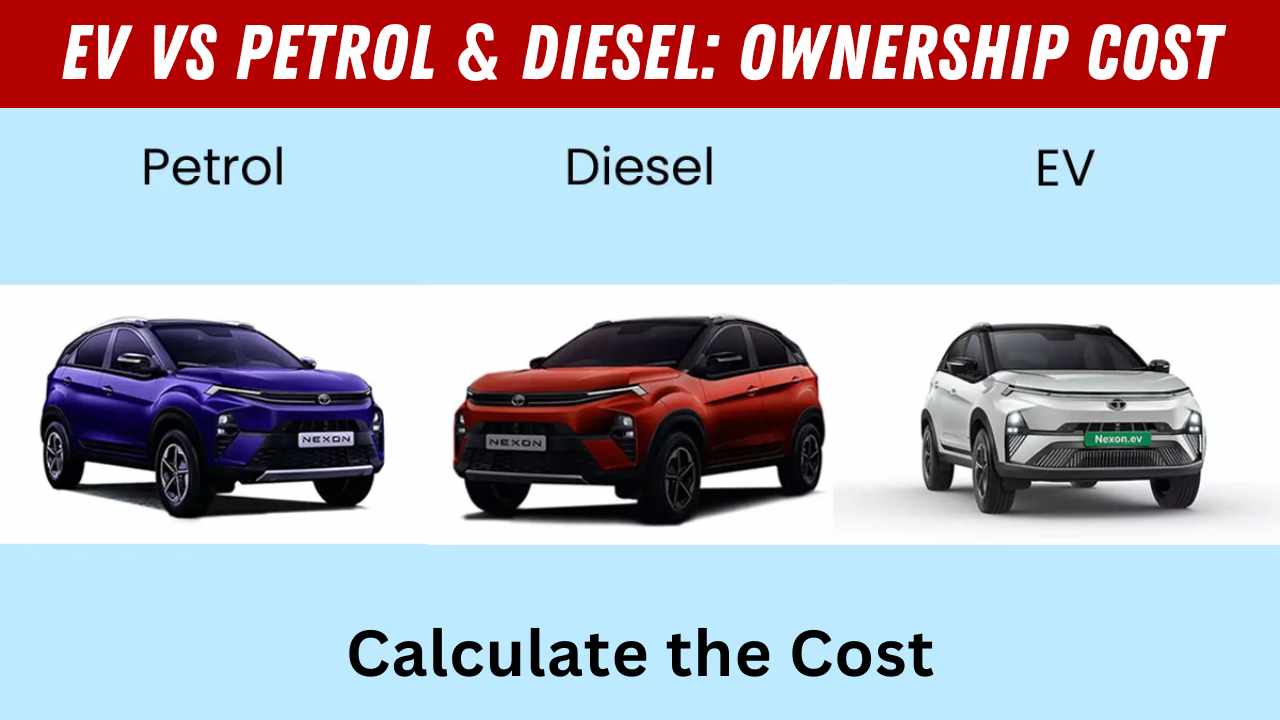EV vs petrol is ultimately a math problem: electricity usually delivers a much lower per‑km energy cost, while petrol cars can start cheaper and sometimes insure cheaper, so the right answer depends on kilometers driven, charging mix, and city‑level fuel prices over five years in India. With India’s 2024 EV charging guidelines capping public‑station tariffs at or below a distribution company’s ACoS until March 31, 2028, the economics favor planned charging and transparent inputs, hence the calculator embedded below for a fair, current comparison.
Why this comparison matters now
- Delhi’s RSP for petrol stands at ₹94.77/litre as of September 24, 2025, and metros vary around ₹95–₹105/litre, so per‑km costs for petrol meaningfully swing by city and mileage assumptions, which a calculator can surface for realistic planning.
- EVs in India often consume approximately 12.9–17.2 kWh per 100 km in Indian driving cycles, which translates into roughly ₹0.8–₹2.0/km depending on home vs public rates and charging losses, making explicit tariff assumptions critical.
- Independent comparisons and portal tests consistently show the EV advantage on running cost, but total ownership converges when higher upfront price and insurance are added, so a 5‑year lens is more honest than per‑km alone.
Let’s Calculate:
EV vs Petrol vs Diesel — Running Cost Calculator
Get simple, friendly estimates based on your driving habits. Select your State, Vehicle type, and Years of ownership. **Click 'Calculate Costs' for results.**
Select your state to load local fuel & electricity tariffs.
Choose the vehicle style and fuel type for calculation.
The period you want to calculate the total running cost for.
Use your estimated annual driving distance. Default: 12,000 km/year.
Enter your fuel vehicle's actual mileage to fine-tune the estimate.
Adjust the percentage of charging done at home vs. public fast chargers.
Cost Estimates 📈
Energy-only running cost shown. This calculation does **NOT** include: maintenance, insurance, taxes, or purchase incentives.
Advanced Settings (Tariff & Loss Overrides)
Percentage overhead for charging inefficiencies. Default is 10%.
Enter a custom home electricity price if needed.
Enter a custom public fast-charge price if needed.
Real‑world running costs: what owners see
EV per‑km cost tends to be ~₹0.9–₹1.4 for compact EVs via home AC charging, rising toward ₹1.6–₹2.0 with frequent DC fast charging, consistent with recent owner reports and public charging tariffs in India.
Petrol per‑km cost at ₹94.77/litre and 15 kmpl is about ₹6.32/km, while even 18 kmpl still implies ~₹5.27/km, reinforcing why energy cost is where EVs usually win by a wide margin.
Independent Nexon comparisons over 5 years show EVs can be total‑cost competitive at ~12,000 km/year when cheap charging is available, though upfront cost keeps totals close, underscoring the need for personalized inputs rather than blanket claims.
Charging tariffs and policy guardrails
- India’s EV Charging Infrastructure‑2024 guidelines recommend a single‑part tariff for EV public chargers not exceeding ACoS through March 31, 2028, with 0.7× ACoS during solar hours and 1.3× ACoS outside, encouraging time‑aware charging habits that lower bills and grid strain.
- In practice, home slabs commonly sit around ₹6–₹8/kWh while public AC/DC can vary from ~₹7–₹20/kWh, so the calculator’s home/public mix slider materially affects EV cost per km outputs.
- Aligning charge schedules with solar‑hour discounts where available is a practical optimization lever the calculator can model explicitly via ToD toggles and a 24‑hour rate profile.
Ownership beyond fuel: maintenance, insurance, and warranty
- Routine maintenance is structurally lower for EVs due to fewer moving parts and no engine oil, though tyre, brake, and coolant items remain, which third‑party analyses and ownership guides reflect in lower 5‑year maintenance lines for EVs.
- Insurance for EVs can be higher than for comparable petrol variants because of higher insured declared values and battery risk, which should be itemized and not buried in averages in order to preserve cost transparency.
- Major OEMs now cite 8‑year/160,000 km battery coverage (and in some cases “lifetime” constructs defined as 15 years for first owners), materially reducing near‑term replacement risk assumptions in a 5‑year TCO model.
State taxes, fees, and incentives
- Delhi’s EV policy framework waives road tax and registration fees for EVs during the policy period and is evaluating extensions and scope changes in a 2.0 draft, which can swing on‑road price deltas meaningfully in the capital.
- National portals aggregate incentive types—registration fee waivers, income‑tax benefits, and purchase support—so the calculator should include a state selection to parameterize on‑road prices correctly by jurisdiction.
- Where no waivers apply, ICE vehicles regain some upfront advantage, pushing break‑even farther out unless annual kilometers are high or charging access is cheap and consistent.
Break‑even dynamics worth modelling
- Independent TCO studies place EV operating costs near ₹1.28/km versus higher fossil counterparts, but the upfront premium can delay payback into year 3–5 depending on kilometers, charging mix, and local taxes—hence the need to model personal usage rather than rely on averages.
- Tiago‑class testing and Nexon‑class analyses show EVs sharply undercut fuel costs but may tie or trail on 5‑year totals if driven less or charged primarily on expensive public DC, which the calculator exposes with sensitivity sliders for mix and tariffs.
- City‑wise petrol and ToD‑aware electricity inputs move results more than most realize; without that granularity, comparisons risk over‑ or under‑stating the EV advantage by thousands over five years.
Quick comparison table
Practical tips to get the “true” answer
- Enter city petrol RSP and realistic kmpl (consider a 10–20% reduction from ARAI for dense urban driving) to avoid optimism bias in ICE costs.
- Set EV consumption between 13–17 kWh/100 km and allocate at least 70–90% home AC charging for typical owners; test sensitivity to 30–50% public DC if highway heavy.
- Apply state policy toggles (road tax/registration waivers) and OEM battery warranty details to reflect the current purchase context accurately.
Quick FAQs
Ques: Is charging an EV cheaper than petrol in India right now?
Ans: Yes, in most cases, especially with home charging, though public DC pricing can narrow the gap if used heavily.
Ques: Does an EV always win over five years?
Ans: Not always, because higher upfront and sometimes higher insurance can offset savings at low annual kilometers or with mostly public DC charging.
Ques: Are charging tariffs regulated?
Ans: Public EV charging follows national guidelines tying tariffs to utility costs with time‑of‑day structures active through March 2028, which encourages cheaper, off‑peak charging behavior.
Que: Do state policies really matter?
Ans: Yes, road tax and registration waivers can shrink the upfront gap and pull break‑even earlier in states that actively support EVs.
Closing thought
EVs usually deliver clear everyday savings, while petrol cars lean on lower upfront price and wide refueling access, so a fast, transparent calculator reveals which side wins for a specific city, driving pattern, and charging mix without any hard math in the article.
Editorial transparency
This article follows Google’s guidance for helpful, reliable, people‑first content and uses AI assistance for drafting with human review for accuracy, clarity, and compliance with policies on metadata and responsible AI use. Sources include government price and policy pages, India‑specific ownership and charging guides, and recent comparison tests to keep the advice current and practical for local conditions.










